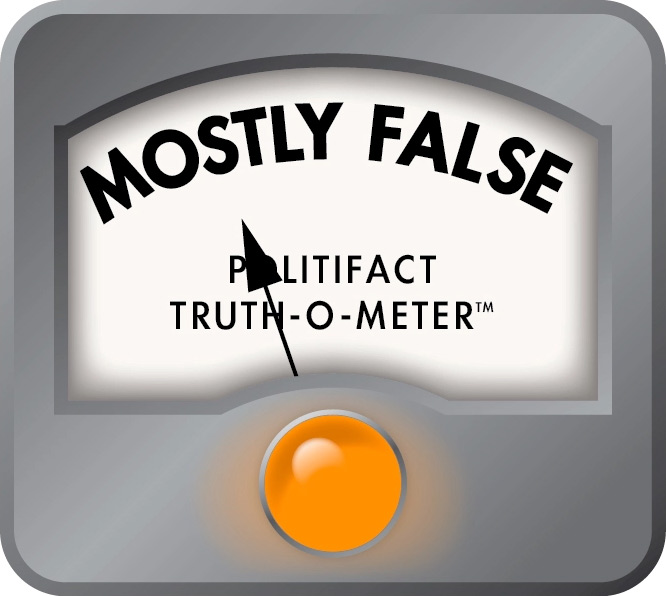RFK Jr. Misses Mark in Touting Rural Health Transformation Fund as Historic Infusion of Cash

“It’s going to be the biggest infusion of federal dollars into rural health care in American history.”

Robert F. Kennedy Jr. on Sept. 4, 2025, in a Senate hearing
At a September Senate hearing, Health and Human Services Secretary Robert F. Kennedy Jr. boasted about a rural health initiative within President Donald Trump’s “One Big Beautiful Bill Act.”
“It’s going to be the biggest infusion of federal dollars into rural health care in American history,” Kennedy said, responding to criticism from Sen. Bernie Sanders (I-Vt.). Sanders said the law would harm patients and rural hospitals.
Kennedy was referring to the law’s five-year, $50 billion Rural Health Transformation Program, HHS spokesperson Emily Hilliard said. GOP lawmakers have made similar claims about the program.
The fund was added to the bill at the last minute to secure support from Republican lawmakers who represent rural states. Some were concerned about how the bill’s Medicaid cuts would harm rural America, where more than 150 hospitals have stopped offering inpatient services or been shuttered completely since 2010, according to the Cecil G. Sheps Center for Health Services Research at the University of North Carolina.
“The transformation fund was really talked about in the context of saving rural hospitals that would be facing these significant Medicaid cuts,” said Carrie Cochran-McClain, chief policy officer at the National Rural Health Association. Medicaid is the joint state-federal health insurance program that primarily covers low-income people and those with disabilities.
So is Kennedy right in his description of the rural health fund as a historic cash infusion, or does it fail to acknowledge critical context?
The Rural Health Transformation Program
Trump’s tax and spending law is expected to reduce federal Medicaid spending in rural areas by at least $137 billion by 2034, according to an analysis by KFF, a health information nonprofit that includes KFF Health News. The Congressional Budget Office predicts the law will increase the overall number of uninsured patients by 10 million by 2034.
Rural health facilities disproportionately rely on Medicaid reimbursement to stay afloat. In 2023, 40.6% of children and 18.3% of adults under age 65 from rural areas and small towns were enrolled in Medicaid, according to the Center for Children and Families at Georgetown University. In metro areas, the rates were 38.2% and 16.3%, respectively.
The Trump administration argues that rural hospitals cannot rely on “legacy” funding sources like Medicaid and Medicare due to the programs’ reimbursement structure, which ties payments to the number of services provided, a model that’s not financially sustainable for rural facilities with typically low patient volumes.
“Distinct from these other programs, the Rural Health Transformation Program is designed to provide a flexible source of investment” to promote innovation, efficiency, and sustainability, the White House wrote in a memo.
Here’s how it works. States can propose projects spearheaded by state agencies, health care providers, consultants, and vendors aimed at various purposes, such as improving technology, access to care, and workforce recruitment.
States can use only 15% of their transformation program funding for provider payments and can direct money to non-rural areas, according to KFF.
Half of the $50 billion will be evenly divided among states whose applications are approved — regardless of their rural and overall populations — according to the “Notice of Funding Opportunity” for the program.
The other half will be awarded based on “the transformative possibilities” of states’ grant proposals; how much they’ve committed to aligning their health policies with the Trump administration’s; and data on their rural population, rural health facilities, uncompensated care, and other measurements.
The application deadline is Nov. 5.
The Big Picture
Michael Meit, director of the Center for Rural Health and Research at East Tennessee State University, said the rural health community is excited about the innovations the new program might foster, but he’d “love for it to happen in the absence of these cuts that are going to devastate our rural health system.”
“It’s not going to fill the hole,” Meit said.
KFF estimates that the rural health fund’s five-year, $50 billion investment is a little over a third of the expected loss of federal funding in rural areas that will be spread over 10 years. According to that analysis, Medicaid cuts over that period would tally at least $137 billion in rural areas.
That number doesn’t account for other reductions stemming from the same law, such as cuts to the ACA Marketplaces or the health system revenue loss expected from an increase in the number of people without insurance.
These factors are important to note because the rural health program is a temporary initiative, while reductions in federal spending are long-term.
Another issue is the difference in the program’s spirit. The rural health fund is focused on transforming the rural health care system — not providing continued funding to keep facilities open or making up for lost Medicaid funds. Even if the money triggers successful innovations, there are doubts that those will happen in time to prevent rural health facilities from closing.
“There’s a real misperception that somehow these funds are going to be able to save rural America or save rural hospitals,” Cochran-McClain said.
Joseph Antos, a health policy expert and senior fellow emeritus at the conservative-leaning American Enterprise Institute, said Kennedy’s comment is something “politicians say when they want to ignore the rest of the policies.”
“What they wanted was to say that they were creating a new program,” Antos said. “Well, this is a very inefficient way to distribute a relatively very small amount of money to hospitals that will incur much larger bad debt over the coming years, thanks to the cuts in Medicaid.”
One Caveat
Experts said that when viewed outside of mandatory programs like Medicare and Medicaid, the $50 billion rural health fund does appear to be unrivaled, especially for a limited, five-year program.
Several mentioned the Hill-Burton Act as another program that significantly boosted rural health care. The law provided loans and grants that modernized or built 6,800 health facilities, many of which were in rural areas, from 1946 to 1997, according to the Health Resources and Services Administration.
Incomplete funding data makes it difficult to account for inflation, said Kelsey Moran, an assistant professor and health economist at the University of Miami.
But she estimated that, during the life of the program, it spent $47 billion in 2024 dollars when using the Consumer Price Index, or $109 billion when using the CPI’s medical care index. The medical index has a higher inflation rate because health prices have risen more than overall prices.
Our Ruling
Kennedy said the rural health fund is “going to be the biggest infusion of federal dollars into rural health care in American history.”
The statement contains an element of truth because the new program could be the most significant one-time investment in rural health funding.
But it ignores critical facts and context that create a different impression.
Federal contributions to rural areas from Medicaid and Medicare easily dwarf this program’s $50 billion mark. The new fund offers states flexibility in how they can allocate resources, meaning there’s no guarantee that all the new funding will go to rural Americans’ health care. The program comes at the same time rural areas are expected to lose far more from Medicaid cuts and an increase in uninsured patients than what the rural health fund infusion can backfill.
Experts say the rural health fund’s cash infusion is canceled out by other parts of Trump’s tax and spending law that call for cuts and policy changes.
We rate this statement Mostly False.
“Watch: Sanders, RFK Jr. Get Into Testy Exchange Over COVID Vaccine, CDC Director’s Firing,” CBS News, Sept. 4, 2025.
“$50B Rural Health ‘Slush Fund’ Faces Questions, Skepticism,” KFF Health News, July 21, 2025.
“Rural Hospital Closures,” Cecil G. Sheps Center for Health Services Research at the University of North Carolina-Chapel Hill, accessed Sept. 15, 2025.
“Senate GOP Mulls Shielding Rural Hospitals From Medicaid Cuts,” Roll Call, June 20, 2025.
“Key Takeaways From CMS’s Rural Health Funding Announcement,” KFF, Sept. 23, 2025.
“Estimated Budgetary Effects of Public Law 119-21, To Provide for Reconciliation Pursuant to Title II of H. Con. Res. 14, Relative to CBO’s January 2025 Baseline,” Congressional Budget Office, July 21, 2025.
“Medicaid’s Role in Small Towns and Rural Areas,” Georgetown University Center for Children and Families, Jan. 15, 2025.
“MEMORANDUM Re: The One Big Beautiful Bill is a Historic Investment in Rural Healthcare,” The White House, undated.
Notice of Funding Opportunity for the Rural Health Transformation Program, government document published on Sept. 15, 2025.
“The Federal Budget in Fiscal Year 2023: An Infographic,” Congressional Budget Office, March 5, 2024.
“The Federal Budget in Fiscal Year 2024: An Infographic,” Congressional Budget Office, March 20, 2025.
“Hill-Burton Facilities Compliance,” HRSA, accessed Sept. 16, 2025.
“Hospital Charity Care & The Hill-Burton Act,” working paper by Kelsey Moran updated on Sept. 15, 2025.
Phone interview with Matthew Fiedler, a senior fellow in economic studies at the Center on Health Policy at The Brookings Institution, Sept. 24, 2025.
Phone interview with Gbenga Ajilore, chief economist, and Allison Orris, director of Medicaid policy at the Center on Budget and Policy Priorities, Sept. 24, 2025.
Phone interview with Larry Levitt, executive vice president for health policy at KFF, Sept. 24, 2025.
Phone interview with Joseph Antos, a health policy expert and senior fellow emeritus at the American Enterprise Institute, Sept. 23, 2025.
Phone interview with Carrie Cochran-McClain, chief policy officer at the National Rural Health Association, Sept. 17, 2025.
Phone interview with Kelsey Moran, assistant professor in the Department of Health Management and Policy at the University of Miami, Sept. 15, 2025.
Phone interview with Alana Knudson, director of the NORC Walsh Center for Rural Health Analysis at the University of Chicago, Sept. 12, 2025.
Phone interview with Michael Meit, director of the Center for Rural Health and Research at East Tennessee State University, Sept. 11, 2025.
kffhealthnews





